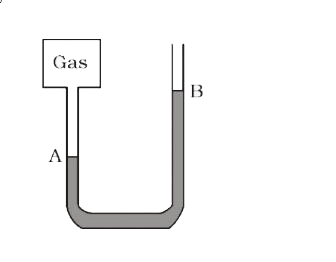Figure shows an ideal gas. Its pressure, volume and temperature are P0,V0 and T0 respectively. Thin U-tube contains mercury. It is seen that when 20 cm of extra mercury is added in limb B of U-tube and temperature of gas is doubled, level of A is maintained at its position. Consider surrounding to be vacuum. Find the initial pressure of gas (in cm of Hg.)

The correct Answer is:20
Let initial pressure be P0
If level A is maintained ⇒ volume remains same
Temperature double ⇒ pressure doubles ∴ 2P0−P0=ρg×20cm ∴ p0 corresponds to 20 cm of Hg
Similar Questions
A constant volume gas thermometer shows pressure readings of 50cm and 90cm of mercury at 00C and 1000C respectively. What is the temperature on gas scale when the pressure reading is 60cm of mercury ?
View SolutionA constant volume gas thermometer shows pressure reading of 50 cm and 90 cm of mercury at 0”∘C and 100”∘C respectively. When the pressure reading is 60 cm of mercury, the temperature is:
View Solution
Knowledge Check
Ten moles of a diatomic perfect gas are allowed to expand at constant pressure. The initial volume and temperature are V0 and T0 respectively. If 72RT0 heat is transferred to the gas, then the final volume and temperature are
A(a) 1.1V0,1.1T0B(b) 0.9V0,0.9T0C(c) 1.1V0,1011T0D(d) 0.9V0,109T0An open U-tube contains mercury. When 11.2 cm of water is poured into one of the arms of the tube, how high does the mercury rise in the other arm from its initial level ?
A0.82 cmB1.35 cmC0.41 cmD2.32 cmOne mole of a monatomic ideal gas has an initial pressure, volume, and temperature of P0,V0, and 438 K, respectively. It undergoes an isothermal expansion that triples the volume of the gas. Then, the gas undergoes an isobaric compression back to its original volume. Finally, the gas undergoes an isochoric increase in pressure, so that the final pressure, volume, and temperature are p0V0 and 438 K, respectively. Find the total heat for this three-step process, and state whether it is absorbed by or given off by the gas.
A3640J absorbedB−1820 J given offC1570 J , absorbedD−1110J , given off
Three insulated vessels of equal volumes V are connected by thin tubes that can transfer gas but do not transfer heat. Initially all the vessels are filled with the same type of gas at a temperature T0 and pressure P0. Then the temperature in the first vessel is doubled and the temperature in the second vessel is tripled. The temperature in the thin vessel remains unchanged. If initial pressure is 77cm of Hg, then find the final pressure (in cm of Hg ) in the system.
View SolutionIf the temperature of a gas is increased by 1K at constant pressure its volume increase by 0.0035 of the initial volume. The temperature of the gas is
View SolutionA constant volume gas thermometer show pressure reading of 50cm and 99 cm of mercury at 0∘C and 100∘C respectively. When the pressure reading is 60 cm of mercury, the temperature is
View SolutionA constant volume gas thermometer shows pressure reading of 50cm and 90cm of mercury at 0∘C and 100∘C , respectively. When the pressure reading is 70cm of mercury, the temperature is
View SolutionA constant volume gas thermopmeter shows pressure reading of 50cm and 90cm of mercury at 0∘C and 100∘C respectively. When the pressure reading is 60cm of mercury, the temperature is
View Solution

